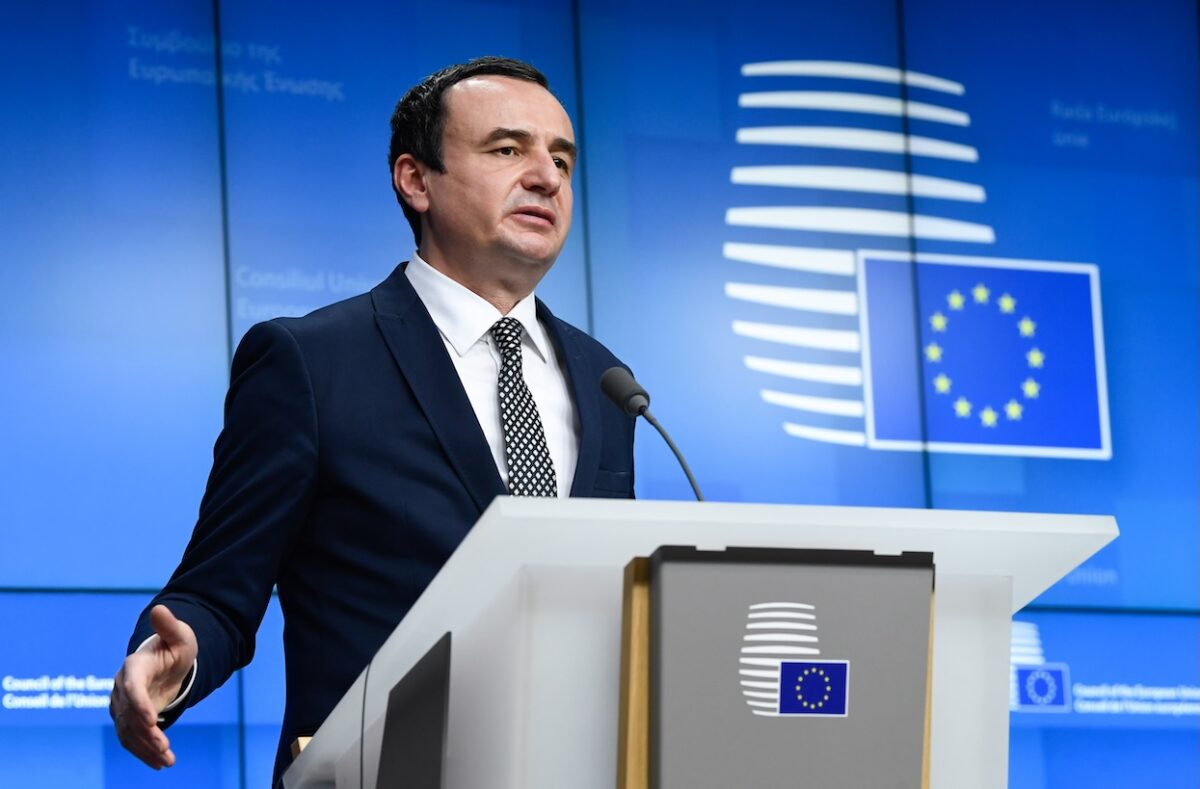In any fair and free national election in Kosovo, most electorates hope that a new chapter will dawn and bring a better prospect for growth, prosperity, and security.
Given the current political atmosphere in Kosovo, the public seems conflicted; a relative majority want to see Prime Minister Albin Kurti back at the helm, but they also want more concrete progress on an array of domestic issues and tangible headway in the Kosovo-Serbia dialogue.
How much of this will be realised will have to await the result of the elections, when the public will see which party will form a coalition government that will be responsive to the public’s needs and expectations.
The upcoming elections are expected to be highly competitive, reflecting the fragmented political environment in Kosovo. There are 28 different political entities, including 20 parties, 5 coalitions, 2 civil initiatives, and 1 independent candidate running in this election.
The main contenders are Kurti’s Vetëvendosje, the Democratic League of Kosovo (LDK) led by Lumir Abdixhiku, and the Democratic party of Kosovo (PDK) led by Memli Krasniqi, who is gaining more support in various municipalities than Kurti.
Since the election campaign started earlier than usual, it has been further aggravated by the tense atmosphere between Serbian and Albanian political parties. The outcome of the election will likely be shaped not only by the country’s domestic concerns but also by the relationship between these parties.
There are some concerns that Serbia might try to disrupt the electoral process, particularly in areas with a majority ethnic Serbian population. Belgrade could encourage voter boycotts and spread misinformation, but there is no hard evidence of Serbian interference. PM Kurti is favoured to win a plurality but not a majority and may need other parties’ support to form the next coalition government. However, the political landscape can shift, though it may not be enough to deny him a second term.
Success and failure
Domestically, during his tenure, Kurti made some inroads on several fronts. Kosovo experienced some economic growth, unemployment was reduced, and minimum wages were increased; fighting organised crime is still a work in progress.
In public administration, there is still an ongoing effort to reform civil services and streamline the salary systems. On defence, Kurti increased the budget for training and military equipment procurement.
However, there have been significant domestic failures as well.
On the economy, no foreign investors have come to Kosovo over the past four years, mainly due to Kurti’s repeated statements that Serbia intends to wage war on Kosovo, discouraging many investors. While imports have increased, exports have decreased, leading to a five billion euros trade deficit. Meanwhile, inflation has risen, and consumer goods have become too expensive for the poor to purchase.
On employment and emigration, according to statistical data, unemployment has averaged 10.7 per cent. Over the past four years, over 150,000 people have left Kosovo. Moreover, in just one year, around 100 doctors and nurses emigrated from Kosovo to EU countries, mainly to Germany, which has provided many employment opportunities for Kosovars.
The health system meanwhile remains ineffective, as many citizens still seek healthcare services in Serbia, North Macedonia, Turkey, and other EU countries. This has resulted in hundreds of millions of euros being spent in recent years on medical treatments abroad.
Leukemia treatments alone can cost around 200,000 euros per person. Moreover, delays in implementing a national strategy to fight corruption are troubling, and nepotism in the government remains unchecked.
There are environmental concerns too. UNICEF recently reported that Kosovo’s air quality contains 25 times the permissible limit of a dangerous pollutant for children, ranking among the worst in Europe.
Kurti’s record on foreign relations is mixed. Kurti has unduly focused on Serbia-Kosovo relations, and the EU-sponsored Ohrid Agreement remains unfulfilled. The tension between Kosovo and Serbia still runs high while Kosovo makes limited headway in relations with other European countries.
Of greater concern is the continuing rocky ties between Kosovo and the EU, which is sine qua non to Kosovo’s security and growth. Moreover, Kurti made little headway in widening ties with other European countries, central to consolidating Kosovo’s independence.
Serbia-Kosovo dialogue
Very little progress was made between Serbia and Kosovo over the past four years. Given the importance of the dialogue, the EU is expected to push for its continuation.
The EU will seek the implementation of the existing agreement, particularly the Ohrid Agreement, known as the Agreement on the Path to Normalisation between Kosovo and Serbia.
One of the most important provisions of the dialogue was implementing the Association of Serb Municipalities, which Kosovo refused to do. At the same time, Serbia’s President Aleksandar Vučić objected to any aspect of the agreement that implied recognition of Kosovo’s independence.
Due to the continuing tension between the two countries, a lack of trust and flexibility will continue to hinder any meaningful progress toward normalisation unless the dynamic of this conflicting issue is changed.
While both parties are facing increasing pressure from the EU and the US, whose involvement is essential to advance the Serbia-Kosovo dialogue, deep-seated historical grievances and conflicting political interests continue to obstruct progress.
Moreover, despite the indispensable role of the EU, its leverage over both countries is limited, especially because the EU cannot offer a clear path to membership.
Danish diplomat Peter Sorensen, who is set to become the special representative of the EU for the Serbia-Kosovo dialogue starting on February 25, is expected to come up with a new strategy seeking practical results rather than engaging in frivolous discussions.
Sorensen’s success will also depend on his ability to foster trust between the parties and encourage mutually beneficial compromises. He is well-positioned to mediate complex issues; however, regardless of what Sorensen proposes, Serbia and Kosovo must be willing to engage with each other constructively. The daunting question is, how can both sides agree on anything when the central issue remains mutual recognition, to which Serbia is adamantly opposed?
Other domestic and foreign challenges
There are several domestic and foreign challenges the new Kosovo government must focus on to meet the people’s expectations.
Although Kosovo’s ultimate goal is to achieve mutual recognition with Serbia, this goal remains elusive. It will not be achieved unless both sides agree on a process of reconciliation that involves concrete steps on the ground.
The following measures must be taken to make some inroads toward mutual recognition: First and foremost, the new government must improve its relations with the EU. Both sides must agree on every issue, especially regarding the Serbia-Kosovo dialogue and all security-related matters.
Second, the new government must honour the previous agreement and implement the Association of Serb Municipalities as long as it is consistent with Kosovo’s constitution. Nothing in the constitution prohibits autonomy for the Serbian-dominated north.
Third, ties between Serbia and Kosovo should be enhanced through trade, cultural exchanges, joint efforts to address environmental problems, water distribution, increased tourism, and many other people-to-people interactions.
Fourth, Kosovo must make every effort to earn recognition from the five EU members—Spain, Cyprus, Slovakia, Romania, and Greece—who have not recognised it, which is a prerequisite for eventual EU membership.
Fifth, Kosovo must earn the support of the Trump administration by demonstrating a willingness to cooperate, especially regarding security and reducing tension with the predominantly Serbian municipalities.
Domestically, the new government should not be fixated on Serbia but focus on several domestic fronts, including weeding out corruption, ending nepotism, making it attractive to foreign investors (which will help create tens of thousands of jobs with higher wages), dramatically improving the healthcare system, making it more attractive for doctors and nurses to stay in the country, addressing the dire need to reduce pollution, investing in schools and universities that focus on technology and computer engineering, and embarking on an aggressive fight against organised crime.
Indeed, all these programmes require significant funding, which can be generated from many sources, including: improving tax compliance, enhancing property tax, issuing bonds for infrastructure projects, receiving grants from the World Bank and additional loans and credit from the International Monetary Fund (IMF), focusing on green transition and private sector support, and developing sustainable development projects.
In addition, receiving EU grants for schools and teacher training, getting further economic aid from the US for building new hospitals and green infrastructure, energy storage, and electric grids, especially for renewable energy, remittances from Kosovars working abroad, and expanding partnerships with private individuals.
To be sure, the new government will have its work cut out for it. Nevertheless, making significant progress would take commitment and consistent effort on all fronts. If Kurti wins and forms the new government, he should learn from his four years of experience. The question is, will he rise to the challenge?
Photo: Albin Kurti. © European Union.







